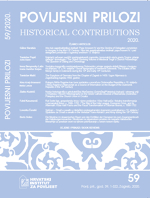Splićani – Croati a cavallo u mletačkim prekojadranskim kopnenim postrojbama u 18. stoljeću
Spalatans as Croati a cavallo in the Venetian Trans-Adriatic Land Army during the 18th Century
Author(s): Lovorka ČoralićSubject(s): Military history, 18th Century
Published by: Hrvatski institut za povijest
Keywords: Split; Dalmatia; Venetian Republic; Cavalleria Croati; military history; 18th century;
Summary/Abstract: As part of the study of the military history of Dalmatia and the Venetian Republic through several centuries of existence in a common state union, the share of Croats in the Venetian military forces has been assessed as extremely significant. Operating as the local (territorial) units, as well as members of professional forces (Fanti oltramarini – infantry; Croati a cavallo, Cavalleria Croati – cavalry), soldiers from Dalmatia made a notable contribution to the preservation of Venetian territorial acquisitions from Veneto (terraferma) to the south of the eastern Adriatic coast. Investigation of this issue is complex and requires an analysis of documents stored in the Archivio di Stato di Venezia and the State Archive in Zadar, as well as other Croatian and international archival institutions and libraries. Following several years of research on this issue, this paper focuses on the role of Spalatans in the Croatian cavalry under the standard of St Mark in the 18th century, and is based on an analysis of sources from the collection of Inquisitori sopra l’amministrazione dei pubblici ruoli in the central Venetian state archives. Based on the said documents, as well as previous historiographical insights, the author focuses on the time frame of the Spalatans’ participation in the abovementioned cavalry unit, the method of their documentation, the duration of military service, the share of members from the same families, personal (physical) features of soldiers, the location of their documentation, and the command staff of the units in which they operated. The presence of Spalatans in Venetian cavalry can been observed throughout the century, while the places of their activity (documentation) reflect the distribution of Venetian acquisitions from the terraferma through Dalmatia and the Bay of Kotor to Greece, also testifying to the mobility of elite Venetian land units. The Spalatan cavalrymen fit into the wider sample of Croatian soldiers in the land forces of the Serenissima at that time in terms of age and personal (physical) features. The lists of soldiers reveal various aspects of the military careers of individual families such as the length of their military service, their career advancement, as well as a number of surnames that we believe can be an interesting source for studying the onomastics of Split during the period in question. The conclusion of the paper is that the Spalatans formed a very notable part of the Croatian cavalry under the standard of St Mark and that the analysis conducted here contributes to the military history of Dalmatia (in this case the city of Split) and the Venetian Republic in the last century of living in a common state.
Journal: Povijesni prilozi
- Issue Year: 2020
- Issue No: 59
- Page Range: 229-249
- Page Count: 21
- Language: Croatian

